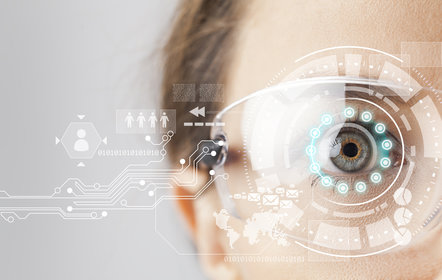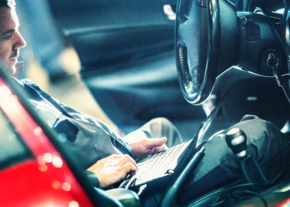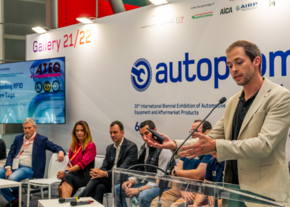
22/03/2017
Automotive experience beyond the five senses
Nicoletta Ferrini
Since their appearance in the advertising and marketing fields, augmented reality and virtual reality are becoming increasingly familiar also in the automotive industry, with new applications aimed at enhancing the designing phase as well as sales and service strategies.
When reality exceeds fantasy. Among the most recent and innovative technologies, augmented reality (AR) and virtual reality (VR) are the ones that, more than most, provide substance and shape to the boldest of imaginations. Virtual Reality is able to simulate an alternative and detached reality from the here and now, in which anyone can interact through specific devices such as Oculus Rifts, wired-gloves, cyber-suits and much more. Augmented reality, instead, amplifies our sensory abilities with information not normally perceive by our five senses. All this is made possible through dedicated apps and mobile devices (smartphones or tablets), wearable devices (Google Glass, Samsung Gear etc.) or simply via a display, which can also be found on a vehicle’s dashboard. Bridging the gap between reality and virtual, AR and VR are attracting a growing number of consumers. After the undeniable success experienced with video games and general entertainment, augmented reality and virtual reality are now making waves into other sectors as well, including the automotive industry.
The automotive world is actually experiencing a small revolution: some of the largest and most famous manufacturers have long since started to experiment with several possible applications. From Audi to Mini, Nissan Toyota and Volkswagen, not a few car builders have been producing commercials able to come alive on a PC or a Tablet screen, thanks to a webcam and a graphic code chart. The use of AR and VR has been instrumental in creating "digital showrooms", where a visit becomes even more compelling, complete and exciting. Audi City showrooms, for example, use specific platforms to give clients the opportunity to visualize, in real time, any variant in the German brand’s range of vehicles as well as single models, going far beyond what could be physically displayed in a traditional showroom. Fiat Chrysler Automobiles too is moving in a similar direction: at the Mobile World Congress in Barcelona last year, the Italian-American manufacturer introduced an innovative app for selling cars - designed and developed by Accenture Digital using the Project Tango software development kit – which makes it possible to view and interact with a full size virtual version of the selected car. Furthermore, augmented and virtual reality allows manufacturers, during the designing stage, to evaluate a considerable number of variants to their models reducing time and costs: Volkswagen, on the other hand, makes extensive use of augmented reality to adapt design patterns to already existing vehicles thus producing, in real time, an accurate analysis of the components used.
Some of the most interesting applications of AR and VR in the automotive field concern the aftermarket. In a not too hypothetical and distant future, both augmented and virtual reality will help manufacturers, mechanics and other sector specialists to offer advanced and timely services even in remote. BMW is currently experimenting the use of augmented reality solutions for maintenance tasks. Through the use of wearable devices, Bavarian engineers, receive, while they work, real time images that help them to speed up the work, such as the correct sequence of the operations to be performed, information on the best tools for each step, and so on. It’s not too difficult to see how these types of solutions can create new scenarios: the combined use of virtual and augmented reality might allow any manufacturer the opportunity to guarantee not only the necessary assistance during repair and maintenance activities, but provide real time and "on demand" training. And it does not end there. This new approach might even go as far as involving the end user. The fact that the latter may soon leave its traditional passive role as viewer to become an active part of the process is now the opinion of many in the industry. Among them we find Hyundai. The South Korean manufacturer has in fact developed an app, which enables customers to know their cars and learn how to perform some of the basic maintenance work.
Augmented reality and virtual reality are already reshaping some of the sector’s traditional dynamics creating new opportunities. Many though, are alarmed by the prospect that this type of technology will inevitably make many specialists unnecessary, including mechanics. Like every revolution, this could trigger a selection process and, as in any revolution, only those who have been able to interpret the changes, riding the wave without being overwhelmed, will remain standing.
The automotive world is actually experiencing a small revolution: some of the largest and most famous manufacturers have long since started to experiment with several possible applications. From Audi to Mini, Nissan Toyota and Volkswagen, not a few car builders have been producing commercials able to come alive on a PC or a Tablet screen, thanks to a webcam and a graphic code chart. The use of AR and VR has been instrumental in creating "digital showrooms", where a visit becomes even more compelling, complete and exciting. Audi City showrooms, for example, use specific platforms to give clients the opportunity to visualize, in real time, any variant in the German brand’s range of vehicles as well as single models, going far beyond what could be physically displayed in a traditional showroom. Fiat Chrysler Automobiles too is moving in a similar direction: at the Mobile World Congress in Barcelona last year, the Italian-American manufacturer introduced an innovative app for selling cars - designed and developed by Accenture Digital using the Project Tango software development kit – which makes it possible to view and interact with a full size virtual version of the selected car. Furthermore, augmented and virtual reality allows manufacturers, during the designing stage, to evaluate a considerable number of variants to their models reducing time and costs: Volkswagen, on the other hand, makes extensive use of augmented reality to adapt design patterns to already existing vehicles thus producing, in real time, an accurate analysis of the components used.
Some of the most interesting applications of AR and VR in the automotive field concern the aftermarket. In a not too hypothetical and distant future, both augmented and virtual reality will help manufacturers, mechanics and other sector specialists to offer advanced and timely services even in remote. BMW is currently experimenting the use of augmented reality solutions for maintenance tasks. Through the use of wearable devices, Bavarian engineers, receive, while they work, real time images that help them to speed up the work, such as the correct sequence of the operations to be performed, information on the best tools for each step, and so on. It’s not too difficult to see how these types of solutions can create new scenarios: the combined use of virtual and augmented reality might allow any manufacturer the opportunity to guarantee not only the necessary assistance during repair and maintenance activities, but provide real time and "on demand" training. And it does not end there. This new approach might even go as far as involving the end user. The fact that the latter may soon leave its traditional passive role as viewer to become an active part of the process is now the opinion of many in the industry. Among them we find Hyundai. The South Korean manufacturer has in fact developed an app, which enables customers to know their cars and learn how to perform some of the basic maintenance work.
Augmented reality and virtual reality are already reshaping some of the sector’s traditional dynamics creating new opportunities. Many though, are alarmed by the prospect that this type of technology will inevitably make many specialists unnecessary, including mechanics. Like every revolution, this could trigger a selection process and, as in any revolution, only those who have been able to interpret the changes, riding the wave without being overwhelmed, will remain standing.






